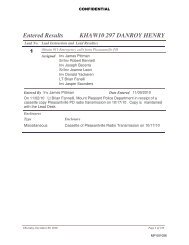Slavery in the Lower Hudson Valley - The Journal News
Slavery in the Lower Hudson Valley - The Journal News
Slavery in the Lower Hudson Valley - The Journal News
You also want an ePaper? Increase the reach of your titles
YUMPU automatically turns print PDFs into web optimized ePapers that Google loves.
A <strong>News</strong>paper-<strong>in</strong>-Education Supplement to <strong>The</strong> <strong>Journal</strong> <strong>News</strong> • LoHud.com<br />
<br />
Max Caulfield<br />
Responses To <strong>Slavery</strong> In New York<br />
Few enslaved Africans had <strong>the</strong> opportunity to express <strong>in</strong> writ<strong>in</strong>g<br />
<strong>the</strong>ir views on <strong>the</strong>ir condition. But based on <strong>the</strong>ir actions it is<br />
clear that captives actively resisted <strong>the</strong>ir oppression through<br />
many responses, both violent and non-violent. <strong>The</strong>re were serious<br />
risks associated with each of <strong>the</strong>se forms of resistance, <strong>in</strong>clud<strong>in</strong>g<br />
separation from family, physical punishment, or death.<br />
Runn<strong>in</strong>g away was one way enslaved men and women <strong>in</strong> <strong>the</strong><br />
North fought <strong>the</strong>ir captivity and thwarted white owners economically.<br />
Many ran to jo<strong>in</strong> family members from whom <strong>the</strong>y had been<br />
separated. One of Frederick Philipse’s enslaved Africans named<br />
Jack ran away from Philipsburg Manor around 1694. Frederick<br />
traced Jack to Stratford, Connecticut, but lost all trace of him<br />
<strong>the</strong>reafter. Frederick assumed Jack had run to Rhode Island and<br />
sailed from <strong>the</strong>re to <strong>the</strong> Gulf of Persia, and he <strong>in</strong>structed his ship<br />
capta<strong>in</strong>s to look for Jack when <strong>the</strong>y sailed to Madagascar.<br />
Some <strong>in</strong>dividuals rebelled aga<strong>in</strong>st enslavement by work<strong>in</strong>g<br />
at a slow pace or pretend<strong>in</strong>g to be ill or unskilled. O<strong>the</strong>rs<br />
stole goods from <strong>the</strong>ir owners. For many enslaved<br />
Africans, preserv<strong>in</strong>g and pass<strong>in</strong>g <strong>the</strong>ir African cultures<br />
on to <strong>the</strong>ir children was an important way<br />
to resist <strong>the</strong> daily oppression of enslavement.<br />
Emancipation In New York<br />
Toward <strong>the</strong> close of <strong>the</strong> eighteenth century, many nor<strong>the</strong>rners began to f<strong>in</strong>d that <strong>the</strong><br />
use of free laborers could be more cost-effective than slavery. By <strong>the</strong> 1760s, emancipation—<strong>the</strong><br />
idea of free<strong>in</strong>g enslaved Africans—became a political issue as <strong>the</strong> colonies<br />
began to appeal for freedom from England. Although <strong>the</strong> Declaration of Independence<br />
did not <strong>in</strong>clude any reference to emancipation, enslaved and free blacks were quick to<br />
use its focus on liberty to press for an end to slavery. Never<strong>the</strong>less, emancipation was<br />
a long process.<br />
In 1788, New York State outlawed <strong>the</strong> slave trade, mak<strong>in</strong>g it illegal to import or<br />
export Africans for sale or for personal use. A series of laws followed, <strong>in</strong>clud<strong>in</strong>g<br />
<strong>the</strong> most important one that established July 4, 1827, as New York’s official<br />
Emancipation Day. On that day freedom was given to all enslaved <strong>in</strong>dividuals <strong>in</strong> <strong>the</strong><br />
state -- just 38 years prior to <strong>the</strong> passage of <strong>the</strong> Thirteenth Amendment, which freed<br />
all enslaved people throughout <strong>the</strong> United Sates.<br />
Enslaved Africans also used violence and destruction <strong>in</strong> <strong>the</strong>ir efforts<br />
to atta<strong>in</strong> liberty, as <strong>in</strong>dividuals and collectively. <strong>The</strong>y damaged<br />
tools, set fire to <strong>the</strong>ir owner’s property or murdered <strong>the</strong>ir masters.<br />
Significant upris<strong>in</strong>gs occurred <strong>in</strong> New York City <strong>in</strong> 1712 and<br />
1741. In <strong>the</strong> trial that occurred after <strong>the</strong> 1741 rebellion, thirty<br />
Africans and four whites were executed; at least seventy-two<br />
Africans were deported. b<br />
What<br />
is History?<br />
We often th<strong>in</strong>k of history as someth<strong>in</strong>g<br />
that has happened, that is over and done<br />
with. But that is not true—history changes<br />
over time. It is not that what happened <strong>in</strong> <strong>the</strong><br />
past changes; ra<strong>the</strong>r, what changes is what people<br />
are <strong>in</strong>terested <strong>in</strong> and <strong>the</strong> way <strong>the</strong> past is viewed<br />
by people <strong>in</strong> <strong>the</strong> present. <strong>The</strong>re are an <strong>in</strong>f<strong>in</strong>ite number<br />
of stories that could be told about <strong>the</strong> history<br />
of <strong>the</strong> world, but obviously <strong>the</strong>re is not an <strong>in</strong>f<strong>in</strong>ite<br />
amount of time to tell <strong>the</strong>se stories. As a result, a<br />
large part of “do<strong>in</strong>g” history is decid<strong>in</strong>g what to<br />
focus on. Because time is limited, <strong>the</strong> decision<br />
to focus on someth<strong>in</strong>g is at <strong>the</strong> same time a<br />
decision not to focus on o<strong>the</strong>r th<strong>in</strong>gs. For<br />
example, at Philipsburg Manor, we have<br />
decided to focus on <strong>the</strong> lives and labor<br />
of <strong>the</strong> enslaved population<br />
at Philipsburg Manor.<br />
In <strong>The</strong> <strong>News</strong> . . .<br />
• Enslaved Africans had few ways to express<br />
<strong>the</strong>ir views <strong>in</strong> writ<strong>in</strong>g to o<strong>the</strong>rs about <strong>the</strong>ir<br />
condition.<br />
• Us<strong>in</strong>g <strong>the</strong> newspaper, f<strong>in</strong>d examples of<br />
<strong>in</strong>dividuals, or groups of <strong>in</strong>dividuals, us<strong>in</strong>g<br />
multiple means of expression.<br />
• One form of express<strong>in</strong>g one’s view <strong>in</strong><br />
newspapers is <strong>the</strong> Editorial page. F<strong>in</strong>d <strong>the</strong><br />
“Letters to <strong>the</strong> Editor.” Write your own<br />
letter to <strong>the</strong> editor about an issue.<br />
Noah Woodley-Aitchison






